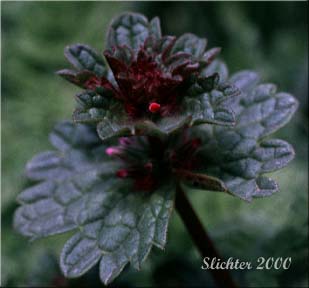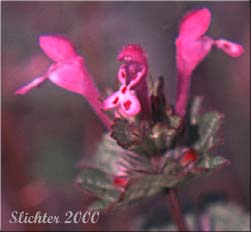Common Deadnettle, Common Dead-nettle, Giraffehead, Henbit, Henbit Deadnettle
Lamium amplexicaule
Synonym: Lamium amplexicaule var. album



Photo at right of the upper clasping leaves of clasping henbit from the Hanna-Arbuckle Rd, SE of Heppner, OR......May 6, 2000.
Henbit is an introduced annual weed. The weak stems are often branched at the base and they spread or ascend up to a length of 30 cm. The stem leaves are opposite, and the upper leaves clasp the squared (in cross-section) stem. The lower leaves are long-petioled, with the length of the petiole reduced in size to about midstem where the clasping leaf bases begin. The blades are rounded or almost heart-shaped, often up to 1.5 cm long. The margins are coarsely toothed or lobed.
The inflorescence is a series of two or three verticels on the apex of the stem. Each verticel has one flower in the axil of the leaf below it, with these leaves often nearly as long as the flower. The hairy, narrow calyx is tubular with 5 slender teeth with acute tips. The calyx measures from 5-8 mm long. The corolla ranges from 12-18 mm long, with a long, slender tube flaring beyond the midpoint to the mouth (not unlike a trumpet). The corolla is purplish with the inside of the lip white with several red spots. The lower lip is reflexed downward while the upper lip is hood-like and measures from 3-5 mm long.
Henbit is found as a "weedy" species in fields and waste places.

The photo at right is of clasping henbit from The Dalles Dam Visitor's Center, The Dalles, OR......April 13, 1991.
Originally native to Eurasia and northern Africa, henbit is now well established throughout North America.
All parts of red dead-nettle are edible, and may be used in salads. Plants should be washed before use, and care must be taken to collect plants which have not been exposed to herbicides or insecticides. Poultices of the fresh plant may help reduce swelling and speed the healing of stings, small wounds, and minor burns. The leaves were used as a tea to reduce both internal or external bleeding, and to relieve diarrhea.